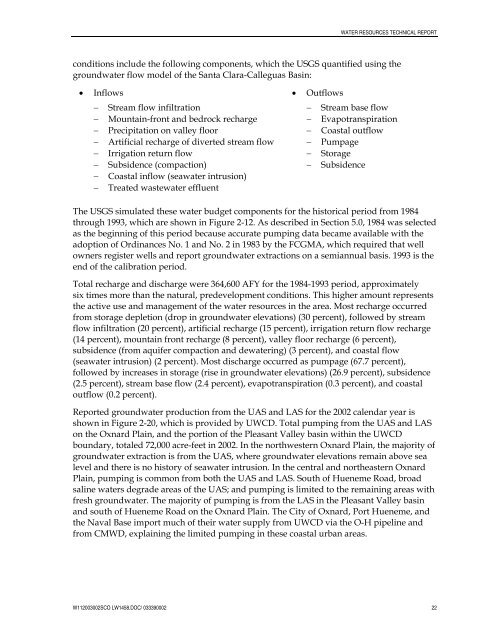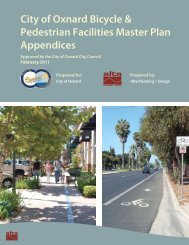View File - Development Services - City of Oxnard
View File - Development Services - City of Oxnard
View File - Development Services - City of Oxnard
Create successful ePaper yourself
Turn your PDF publications into a flip-book with our unique Google optimized e-Paper software.
WATER RESOURCES TECHNICAL REPORTconditions include the following components, which the USGS quantified using thegroundwater flow model <strong>of</strong> the Santa Clara-Calleguas Basin:• Inflows− Stream flow infiltration− Mountain-front and bedrock recharge− Precipitation on valley floor− Artificial recharge <strong>of</strong> diverted stream flow− Irrigation return flow− Subsidence (compaction)− Coastal inflow (seawater intrusion)− Treated wastewater effluent• Outflows− Stream base flow− Evapotranspiration− Coastal outflow− Pumpage− Storage− SubsidenceThe USGS simulated these water budget components for the historical period from 1984through 1993, which are shown in Figure 2-12. As described in Section 5.0, 1984 was selectedas the beginning <strong>of</strong> this period because accurate pumping data became available with theadoption <strong>of</strong> Ordinances No. 1 and No. 2 in 1983 by the FCGMA, which required that wellowners register wells and report groundwater extractions on a semiannual basis. 1993 is theend <strong>of</strong> the calibration period.Total recharge and discharge were 364,600 AFY for the 1984-1993 period, approximatelysix times more than the natural, predevelopment conditions. This higher amount representsthe active use and management <strong>of</strong> the water resources in the area. Most recharge occurredfrom storage depletion (drop in groundwater elevations) (30 percent), followed by streamflow infiltration (20 percent), artificial recharge (15 percent), irrigation return flow recharge(14 percent), mountain front recharge (8 percent), valley floor recharge (6 percent),subsidence (from aquifer compaction and dewatering) (3 percent), and coastal flow(seawater intrusion) (2 percent). Most discharge occurred as pumpage (67.7 percent),followed by increases in storage (rise in groundwater elevations) (26.9 percent), subsidence(2.5 percent), stream base flow (2.4 percent), evapotranspiration (0.3 percent), and coastaloutflow (0.2 percent).Reported groundwater production from the UAS and LAS for the 2002 calendar year isshown in Figure 2-20, which is provided by UWCD. Total pumping from the UAS and LASon the <strong>Oxnard</strong> Plain, and the portion <strong>of</strong> the Pleasant Valley basin within the UWCDboundary, totaled 72,000 acre-feet in 2002. In the northwestern <strong>Oxnard</strong> Plain, the majority <strong>of</strong>groundwater extraction is from the UAS, where groundwater elevations remain above sealevel and there is no history <strong>of</strong> seawater intrusion. In the central and northeastern <strong>Oxnard</strong>Plain, pumping is common from both the UAS and LAS. South <strong>of</strong> Hueneme Road, broadsaline waters degrade areas <strong>of</strong> the UAS; and pumping is limited to the remaining areas withfresh groundwater. The majority <strong>of</strong> pumping is from the LAS in the Pleasant Valley basinand south <strong>of</strong> Hueneme Road on the <strong>Oxnard</strong> Plain. The <strong>City</strong> <strong>of</strong> <strong>Oxnard</strong>, Port Hueneme, andthe Naval Base import much <strong>of</strong> their water supply from UWCD via the O-H pipeline andfrom CMWD, explaining the limited pumping in these coastal urban areas.W112003002SCO LW1458.DOC/ 033390002 22
















